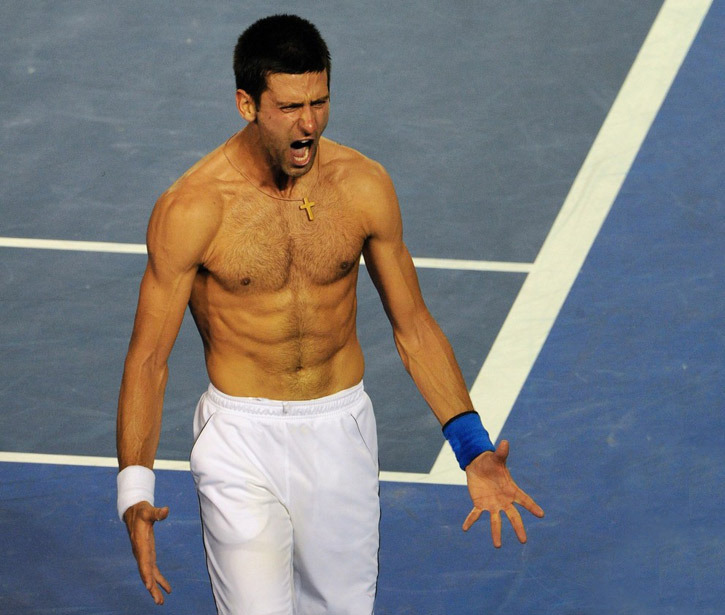Whatever the sport, strength training, in harmony with various training factors (i.e., technical, tactical, physical and psychological) and training principles (i.e., overload, specificity, reversibility, heterochronism, specialization, continuity, progression, cyclicity, individualization and multilateralism) will endow the athlete with a complete set of tools in order to maximize performance.
In tennis, strength is used to generate speed, power and endurance. It is impossible to have agility, speed, power, a developed anaerobic system, and flexibility / mobility without optimal strength levels (Verstegen, 2003). Strength training is also critical to prevent injury. Because tennis is a sport that involves many repetitions of movements of unilateral features, it is conducive to developing muscular imbalances which significantly increase the likelihood of injury. In tennis, the highest incidence of injuries is in the shoulders and back, followed by injuries in the elbows, knees and ankles (Kibler & Chandler, 1994). Thus, specific strength training for tennis is essential to maintain or restore proper muscle balance.
Definition of Force
The definition of force based on its purely mechanical concept consists of any cause capable of modifying the state of rest or motion of a body, consisting of a vector with a given magnitude and direction. It is the product of mass by acceleration (F=m*a). Although this definition of force is unanimously accepted, it hardly illustrates the different components of muscle strength. That is, if we understand muscle strength as an essential component for the development of motor skills which consists of the ability to apply force to overcome resistance (O’Sullivan & Schmitz, 1998).
Why Strength Training in Tennis?
A strength training program in the context of tennis should aim at developing “highly innervated muscles with an explosive ability” so that players can serve with greater speed, so that they can put “more weight” on the ball (due to an improved use of ground reaction forces), so that they can cover more area on court (because they are more agile and fast), and so that they feel as if they “float” on the court the whole day and week (Verstegen, 2003). It is important though to dispel some myths regarding strength training, namely that this type of training will make players slower, less agile or tight. Only poorly designed strength training programs will lead to this. In fact, several studies show that amongst Olympic athletes, weightlifters are those displaying the highest levels of power and are second best (after gymnasts) regarding flexibility levels (Jensen & Fisher, 1979).
It has been well established that adequate strength training not only maintains levels of flexibility but can actually significantly increase them (Fox, 1984; Jensen & Fisher, 1979; O’Shea, 1976; Rash, 1979). Also, adequate strength training induces significant improvements in: work capacity; body composition (i.e., lean mass gains and loss of fat mass); energy efficiency; tissue growth hormonal secretion profile favoring protein synthesis (e.g. strength training induces growth hormone secretion and testosterone); posture; and muscle balance (Lamb, 1984; Stone et al., 1982).
Specifically in tennis, it has been shown that strength training strengthens the immune system (thus protecting the player from injury and illness), and is often pointed to have a positive psychological effect on players, since it appears to be coupled with an increase in levels of self-confidence during matches (Folkins & Sime, 1981; Tucker, 1983), as out of the game (Folkins & Sime, 1981).
The Various Types of Strength and Its Application in Tennis
- Strength endurance: the ability to produce force over time while resisting to fatigue. Good strength endurance levels allow the maintenance of proper form and a correct technical execution. Together with the static strength, strength endurance makes a sort of a basis for developing other types of strength training in tennis.
- Static strength: the ability to stabilize joint structures allowing better transmission of energy along the kinetic chain, i.e. without loss of energy. In tennis, this type of strength allows optimal use of force generated against the ground to subsequently transfer speed to the ball.
- Maximal strength: relates to the maximal force value during a voluntary contraction against an immovable resistance. It is mainly a strength assessment parameter and we can consider its absolute and relative measures (i.e. relative to body weight). For tennis, relative strength is more relevant than absolute strength because it has a direct influence on the player’s speed and agility. Strength Deficit (SD) should also be evaluated based on measures for Maximum Eccentric Force (MEF) and Maximum Isometric Force (MIF). The SD = MEF-MIF. If the SD > 25% for the lower limbs, and SD > 50% for the upper limbs, training should prioritize Rate of Force Development (RFD). If below these values, strength training should focus on hypertrophic and maximal strength methods.
- Power – the ability to produce the most amount of force in the shortest time interval. It includes:
- Starting strength (up to 250ms of the force / time curve) –expressed as the Initial Force Production Rate (IFPR) and reveals the ability to accelerate from a static position (i.e., velocity = 0);
- Explosive force (above 250 ms of the force / time curve) – expressed as the Maximum Force Production Rate (MFPR) and reveals the ability to accelerate to maximum force levels. It is one of the main indicators of performance in tennis. It corresponds to the phase of maximum acceleration during a given movement;
- Reactive force – force produced during muscle’s stretch-shortening cycle (SSC). The use of the elastic and reflex properties of the muscle present in the SSC influences the IFPR and the MFPR. Reactive force training (i.e., using muscle’s SSC) may contribute to increased acceleration capacity, that is, increasing IFPR and the MFPR, and consequently gains in power.
- Optimal Strength (Verstegen, 2003): the combination of the types of strength described above according to aspects inherent to the player and his/her performance, such as: age; capacities; style of playing; stage of development; type of surface on which they will play.
Table 1 specifies the ideal characteristics of strength training in tennis for the various stages of development according to the Long-term Athletic Development model (Balyi & Hamilton, 1999).
| Table 1. | |||
| Age | Characteristics | ||
| 6-9 Boys 6-8 Girls | Strength training should focus on exercises with body weight. It may include the use of medicinal balls (of adequate weight) in exercises of a playful nature. The strength gains at this age are mainly attributed to gains in motor coordination and neuromuscular activation. | ||
| 9-12 Boys 8-11 Girls | Strength training should be regular and lead to progressive improvements. At this stage, however, emphasis should be placed on motor learning and development. | ||
|
12-16 Boys 11-15 Girls | Strength training should be characterized by short sessions (less than 30 minutes) two to three times a week. The Peak Height Velocity (PHV) will determine the increase in volume and intensity of the loads. Critical periods for strength training will occur shortly after PHV for girls, and 12-18 months after PVA for boys. Basic Olympic lifts techniques should be introduced and mastered during the PHV. This can constitute an important training tool “in the box” for later development high levels of power, as well as preventing injuries and optimize adaptation to strength training. | ||
| 16-18 Boys 15-17 Girls | Strength training should be regular and lead to progressive improvements. Regular assessment of strength deficit should be made to determine if training should be more hypertrophy or RFD oriented. It should have a special emphasis on possible muscular imbalances due to the higher levels of intensity and volume related to tennis training and tournaments | ||
| Adulthood | The training should be regular and lead to progressive improvements. However, training should spot imbalances, inadequacies and weak points of the athletes in order to optimize performance in tennis in the long term. | ||
Conclusion
In short, a strength training program should consist of integration of stability and recovery / corrective exercises, together with strength work of both maximal and explosive characteristics, as well as court work focusing strength components such as speed, agility and power.
References
Balyi, I. & Hamilton, A. (1999). The FUNdamentals in Long-term Preparation of Tennis Players. In N. Bollettieri (Ed.). Nick Bolletieri Classic Tennis Handbook, (pp. 258-280). New York: Tennis Week.
Folkins, C. H. & Sime, M. E. (1981). Physical training and mental helath. Journal of Physiology, 36, 373-389.
Fox, E.L. (1984). Sports Physiology (2nd edition). Philadelphia: W.B. Saunders.
Jensen, C. R. & Fisher, A. G. (1979). Scientific Basis of Athletic Conditioning. Philadelphia: Lea & Fegiber.
Kibler, W. B. & Chandler, T. J. (1994). Raquet Sports. In F.Fu &D. Stone (Eds.), Sports injuries: Mecahnisms, Prevention, and Treatment. Baltimore: Williams & Williams.
Lamb, D. R. (1984). Physiology of Exercise (2nd edition). New York: MacMilan.
O’Shea, J. P. (1976). Scientific principles and Methods of Strength Fitness (2nd edition). Reading: Addison.Wesley.
O’Sullivan, S. B. & Schmitz, T.J. (1998). Strategies to improve motor control and motor learning. Physical Reabilitation: Assessment and Treatement (3rd edition) (pp.225-244). Philadelphia: F.A. davis.
Rasch, P. J. (1979). Weight Training (3rd edition). Duduque: Wm. C. Brown.
Stone, M. H., Byrd, R., Carter, D. et al. (1982). Physiological effects of short-term resistive training on middle-age sedentary men. National Strength and Conditioning Association Journal, 4, 5, 16-20.
Tucker, L. A. (1983). Self Concept: Afunction of self-perceived somatotype. Journal of Psycology, 113, 123-133.
Verstegen, M. (2003). ITF Strength & Conditioning for Tennis. In M. Reid, A. Quinn, & M. Crespo (Eds), Developing strength (pp. 113-135). London: ITF Ltd.

